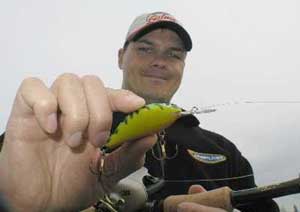
Walleyes love minnows. Northerns love minnows. Almost every freshwater fish enjoys a meal of minnows. But how do they choose which silvery-scaled side dish to pluck from the millions of pelagic wanderers? Do predators pick out the feable or go for the nearest contestant? These are important questions to think about, since a popular bait of choice, the crankbait, is one fantastic minnow imitator.
Right out of the box, a crankbait can catch fish. Cast it out and reel it in right? Well, doing so does produce, but since fish act upon instinct, the crankbait needs to trigger an instinctive response. A casual swim through the middle of the water column will pass a few salivating mouths, but coercing the fish to approach your bait from a distance should be the anglers goal. This can be accomplished by focusing upon and fine-tuning your presentation based upon understanding a few basic crankin’ attributes.
Action
The action of the bait is determined in whole by the manufacturer. It’s body design, lip, composition material and weight all contribute to the roll, wiggle and sweep of the bait. Although companies produce thousands of seemingly identical baits, some will vary in performance due to minute differences in composition. A slight deviation in a lures action is a magical rhythm that can trigger a response from a wider variety of fish. When you find the one in a million bait, indicate its superiority with a permanent marker to make the bait easily identifiable from your “other” baits.
Speed
Time of year and water temperatures often influence the speed of retrieval. Early season and cool water means lethargic fish and slow cranking. These fish don’t want to expend more energy than necessary, so slow moving crankbaits give the fish a longer period of time to react. Warmer water finds fish eager to chase down faster moving baits, but in either situation, changing speed during the retrieve is what gets attention.
It’s difficult not to get excited as numerous fish are caught and there’s a tendency to crank faster with each cast when the adrenaline starts pumping. Take a deep breath and cognitively focus upon how you caught the first few fish, imitating the previous successful retrieves.
 Cadence
Cadence
An angler dictates the crankbaits cadence. Are you marching the lure back to boatside without hesitating, or are you employing a stop and go technique? Pausing will cause a crankbait to float toward the surface, sink, or remain suspended dependent upon the type of crankbait you’re casting. Changing a lures cadence is an excellent technique for eliciting a strike and can be accomplished by sporadically stopping the retrieve, twitching and pumping your fishing rod, or making the bait come into contact with structure. Bouncing the bait off structure and ripping it out from weeds are both ways to peak a fish’s interest.
Sound
Fish do have the ability to hear by use of their inner ear, which consists of a series of canals and a chamber that looks like a bowl of milk (fluid) with a single Cheerio (bone) floating in the center. Fine hairs extend from the perimeter of the “bowl” toward the center and when the fish encounters sound in the water, those hairs begin to flutter and the “Cheerio” vibrates, giving the fish an indication that there is food nearby. Because water is much denser than air, sound travels 5 times faster and is 20 times louder underwater, which alone makes a strong case for lure companies to load a crankbait with buckshot. However, the sound produced by rattles seems most effective in waters that are dirty or turbid since fish (and humans) that have dramatically smaller visual fields adapt by relying more heavily upon their other senses. Crankbaits with rattles posses an added sensory attraction because the sound engages the inner ear receptors in addition to sight and feel receptors, making a crankbait one extremely effective fish-catching tool that no angler should be without










